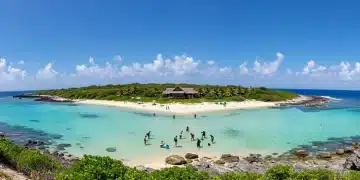The Rise of Sustainable Travel: Trends & Tips for Eco-Conscious Travelers

The rise of sustainable travel reflects a growing global awareness of environmental and social responsibility, leading to innovative practices that minimize tourism’s negative impacts while maximizing its benefits for local communities and ecosystems.
The modern traveler is increasingly aware of their impact on the planet. The rise of sustainable travel isn’t just a trend; it’s a conscious shift towards responsible tourism. Join us as we explore the evolving landscape of eco-friendly adventures and how you can be a part of it.
Understanding the Sustainable Travel Movement
Sustainable travel is more than just a buzzword; it represents a fundamental change in how we approach tourism. It’s about making choices that benefit both the environment and the local communities we visit.
At its core, sustainable travel aims to minimize the negative impacts of tourism, such as pollution, resource depletion, and cultural disruption. It also seeks to maximize the positive contributions of tourism, such as economic benefits for local businesses, conservation of natural resources, and promotion of cultural understanding.
Key Principles of Sustainable Travel
There are several key principles that guide sustainable travel practices:
- Environmental Protection: Minimizing pollution, conserving natural resources, and protecting biodiversity.
- Community Benefits: Supporting local economies, respecting local cultures, and ensuring fair labor practices.
- Responsible Consumption: Reducing waste, using resources efficiently, and making informed purchasing decisions.
- Cultural Preservation: Respecting local traditions, supporting cultural heritage, and promoting cultural exchange.
Ultimately, sustainable travel is about creating a positive and lasting impact on the destinations we visit and the people who call them home. It’s about traveling in a way that enriches our experiences while preserving the planet for future generations.

Eco-Friendly Accommodations: Staying Responsibly
Choosing the right accommodation is a crucial step in sustainable travel. Eco-friendly accommodations go beyond simply reducing energy consumption; they prioritize sustainability in every aspect of their operations.
These accommodations often implement various green practices, such as using renewable energy sources, conserving water, reducing waste, and sourcing local and organic food. They also engage with local communities, providing employment opportunities and supporting local initiatives.
Types of Eco-Friendly Accommodations
There are several types of accommodations that prioritize sustainability:
- Eco-Lodges: Located in natural settings, eco-lodges are designed to minimize their environmental impact and often offer educational programs about the local ecosystem.
- Green Hotels: These hotels implement various green practices, such as energy-efficient lighting, water-saving fixtures, and recycling programs.
- Sustainable Resorts: These resorts are committed to sustainable tourism practices, including environmental protection, community engagement, and responsible consumption.
By choosing eco-friendly accommodations, travelers can reduce their environmental footprint and support businesses that are committed to sustainability. It’s a win-win situation that benefits both travelers and the planet.
Sustainable Transportation: Reducing Your Carbon Footprint
Transportation is a significant contributor to carbon emissions in the tourism industry. Choosing sustainable transportation options is essential for minimizing your environmental impact while traveling.
Sustainable transportation involves selecting modes of transport that have lower carbon emissions, such as trains, buses, and bicycles. It also includes adopting practices that reduce your carbon footprint, such as flying less frequently, choosing direct flights, and offsetting your carbon emissions.
Tips for Sustainable Transportation
Here are some tips for reducing your carbon footprint while traveling:
- Choose public transportation: Opt for trains, buses, and local transportation whenever possible.
- Fly less frequently: Consider traveling by train or bus for shorter distances.
- Offset your carbon emissions: Purchase carbon offsets to compensate for the emissions generated by your flights.
- Walk or bike: Explore your destination on foot or by bicycle whenever possible.
By making conscious choices about transportation, travelers can significantly reduce their carbon footprint and contribute to a more sustainable tourism industry. It’s about prioritizing environmentally friendly options and adopting practices that minimize your impact on the planet.
Supporting Local Communities: Empowering Local Economies
One of the most important aspects of sustainable travel is supporting local communities. This involves investing in local businesses, respecting local cultures, and ensuring that tourism benefits the people who live in the destinations we visit.
By supporting local communities, travelers can help empower local economies, create employment opportunities, and preserve cultural heritage. It’s a way of giving back to the communities that welcome us and ensuring that tourism contributes to their well-being.
How to Support Local Communities
Here are some ways to support local communities while traveling:
- Shop at local markets: Buy souvenirs and products from local artisans and businesses.
- Eat at local restaurants: Sample authentic cuisine and support local chefs and food producers.
- Stay in locally owned accommodations: Choose guesthouses, homestays, and small hotels that are owned and operated by local families.
- Engage with local guides: Hire local guides to learn about the history, culture, and environment of your destination.
Supporting local communities is a way of ensuring that tourism benefits the people who live in the destinations we visit. It’s about creating a positive and lasting impact on the communities that welcome us and contributing to their economic and cultural well-being.

Responsible Consumption: Reducing Waste and Conserving Resources
Responsible consumption is a crucial element of sustainable travel. It involves reducing waste, conserving resources, and making informed purchasing decisions that minimize your environmental impact.
By adopting responsible consumption practices, travelers can help reduce pollution, conserve natural resources, and promote sustainable lifestyles. It’s about being mindful of your consumption habits and making choices that benefit both the environment and the local communities you visit.
Practical Tips for Responsible Consumption
Here are some practical tips for reducing waste and conserving resources while traveling:
- Bring your own reusable water bottle: Avoid buying bottled water by refilling your own bottle at water fountains or refill stations.
- Use reusable shopping bags: Bring your own shopping bags to avoid using plastic bags at stores and markets.
- Say no to single-use plastics: Refuse plastic straws, utensils, and other single-use items.
- Conserve water and energy: Turn off lights and faucets when not in use, and take shorter showers.
Responsible consumption is a way of minimizing your environmental footprint and promoting sustainable lifestyles. It’s about being mindful of your consumption habits and making choices that benefit both the environment and the local communities you visit.
The Future of Sustainable Travel: Innovations and Trends
The sustainable travel movement is constantly evolving, with new innovations and trends emerging every year. These advancements are helping to make travel more environmentally friendly, socially responsible, and culturally enriching.
Some of the key trends shaping the future of sustainable travel include the rise of regenerative tourism, the adoption of technology to enhance sustainability efforts, and the growing demand for authentic and immersive experiences.
Emerging Trends in Sustainable Travel
Here are some of the emerging trends in sustainable travel:
- Regenerative Tourism: This approach goes beyond minimizing negative impacts and aims to actively restore and enhance the environment and local communities.
- Technology for Sustainability: Apps and platforms that help travelers find eco-friendly accommodations, transportation options, and activities.
- Authentic Experiences: A growing demand for immersive cultural experiences that connect travelers with local communities and traditions.
Conclusion
| Key Point | Brief Description |
|---|---|
| 🌱 Eco-Friendly Stays | Choosing accommodations that minimize environmental impact. |
| ✈️ Sustainable Transport | Opting for lower-emission travel methods. |
| 🤝 Local Support | Investing in local economies and businesses. |
| ♻️ Responsible Consumption | Reducing waste and conserving resources while traveling. |
FAQ Section
▼
Sustainable travel aims to minimize negative tourism impacts while benefiting local communities and the environment. It involves responsible choices in accommodation, transportation, and activities.
▼
Look for certifications like LEED or Green Globe, or check if accommodations use renewable energy, conserve water, and support local communities. Online travel platforms often offer eco-friendly filters.
▼
Sustainable transportation includes trains, buses, and cycling. Consider flying less, choosing direct flights, and offsetting carbon emissions when air travel is necessary for your journey.
▼
Supporting local communities ensures tourism benefits residents financially, preserves cultural heritage, and promotes sustainable development. Shop at local markets, eat at local restaurants, and engage with local guides.
▼
Regenerative tourism actively restores and enhances environments and local communities, going beyond minimizing negative impacts. It aims to leave a positive legacy through conservation, education, and community empowerment.
Conclusion
The rise of sustainable travel is a testament to the growing awareness and responsibility of travelers worldwide. By embracing eco-friendly practices, supporting local communities, and making conscious choices, we can create a more sustainable and enriching travel experience for ourselves and for future generations. The journey towards sustainability is ongoing, and every step counts in preserving the planet and its diverse cultures.





